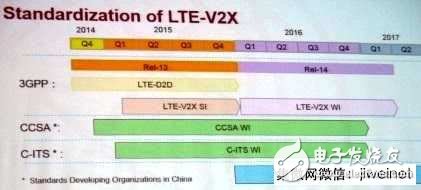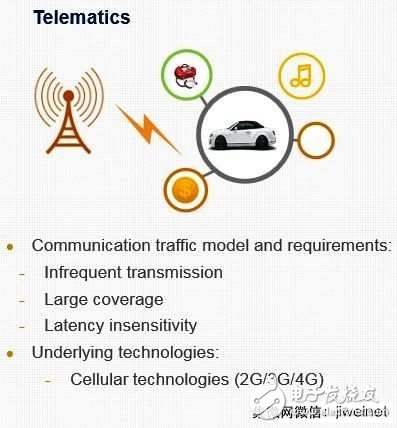Huawei and Qualcomm, two major cellular technology providers, are actively promoting a vehicle-to-vehicle (V2V) and vehicle pair, collectively referred to as “V2Xâ€, by proposing a new LTE standard, LTE V2X. Infrastructure (V2I) business opportunities; this move is now fully developed and tested by automotive technology suppliers for more than a decade, and is also dedicated to V2X applications for Dedicated Short-Range CommunicaTIons (DSRC) Hit the stage.
The DSRC is an IEEE 802.11p-based standard that uses proprietary radio frequencies—the 75MHz spectrum in the 5.9GHz band—which was assigned to the Intelligent Transportation System (ITS) by the Federal Communications Commission (FCC) in 1999. . At the same time, LTE V2X supporters are based on LTE cellular networks as the basis for V2X; they claim that the LTE-Direct (LTE-D), or LTE D2D (Device-to-Device) technology, Can provide a good foundation for LTE V2X. It is understood that LTE-D has the ability to find thousands of devices and services within 500 meters, so that two or more closest LTE-D devices can communicate within the network.

Standard long-term development has led the DSRC camp to compete with other vendors that are vying for a place in the automotive industry with emerging 5G cellular standards. The cellular industry expects 5G to provide native support for automotive communications. . According to EE TImes's recent exchanges with a number of automotive technology suppliers during the ITS World Congress in Bordeaux, France, most of them launched V2X communication at the last minute for Huawei and Qualcomm. The practice of alternative technology is clearly not very satisfactory.
Lars Reger, chief technology officer of NXP's automotive business unit, believes that DSRC has gone a long way, passing a series of field tests over the past few years and preparing to enter new connected cars; he pointed out that LTE V2X is still under development. At the stage, it is expected that the completion of the new standards and the time-consuming adoption and acceptance of the automotive industry will be significantly delayed.

Huawei's timetable shows that the LTE-V2X research project will be completed by the end of this year, and its work project will start in 2016.
Who is the technical pusher?
So the question is: After the car manufacturers have been pondering and slowing down for more than 15 years, are there any problems in the design of the DSRC into the car design? When asked if the car manufacturer has asked them to design V2X replacement technology, Huawei even Jiansong Gan, director of network automotive technology, paused for one second and replied: "This is a good question;" However, he pointed out that the advantage of promoting LTE-based V2X technology is: "LTE cellular network infrastructure already exists," so there is no need Re-establish the V2X infrastructure to support DSRC.
Gan also pointed out that the 5.8GHz DSRC will have potential interference problems in China: “In China, we need a different V2X solution;†Chinese CommunicaTIon Standards AssociaTIon (CCSA) has launched for LTE V2X in China. Work Item.
In response to possible competition between DSRC and LTE V2X, Guang Yang, a senior analyst at Strategy Analytics, a market research organization, said: DSRC: "It is still the mainstream technology of V2X; technically, DSRC has no problems... I think." Explain that the main goal of LTE V2X is not necessarily a solution to the problem (DSRC): “But it has created new business opportunities for the cellular industry.â€
DSRC vs. LTE V2X
Let's analyze DSRC and LTE V2X in detail; as Huawei's Gan said, the biggest advantage of LTE V2X is that it can reuse existing cellular infrastructure and spectrum; Strategic Analytics' Yang said: "Operators do not need to build special The road side unit (RSU) and the dedicated spectrum."
At the same time, the IEEE 802.11p DSRC is basically a half-set 802.11a system, which is an approved IEEE 802.11 standard revision, adding a wireless link in the vehicle environment and communication system; Yang means that the DSRC is basically Wi-Fi technology. "So in theory, LTE can provide better service quality than DSRC."
On the other hand, Yang said: "The LTE-based V2X technology is more complex and the market size is smaller than Wi-Fi; the DSRC standard is now ready, but LTE V2X is still in the research stage. LTE may bring some functions. Strengthening, but it may also create new problems."
Not everyone believes that LTE is a better V2X technology, especially when disaster strikes. Nir Sasson, CEO of Autotalks, a vehicle networking technology provider, said: "I was in Japan on the day of the March 11th 2011 earthquake/tsunami. It took me at least 20 minutes to finally send a newsletter to my wife." He recalled that Japan's cellular communication network was almost shut down at the time: "I don't think we would want V2X to rely on cellular network infrastructure."
Autotalks has partnered with STMicroelectronics to introduce the V2X family of chips – including a complete V2X stand-alone solution and a solution to add V2X functionality to the hardware; the company says it will launch for the public The market optimized V2X chipset to accommodate a large number of markets in 2017.
According to Huawei's LTE-V2X briefing at an ITU seminar in Beijing in July, proponents of the technology pointed out that 802.11p-based DSRC deployment faces several problems; for example, its performance cannot be guaranteed. Because 802.11p is a special mechanism.
In addition, the company pointed out that the dedicated spectrum for V2V road safety is limited to 10MHz in the United States and 30MHz in Europe. In addition to the cost of arranging remote information processing devices (telematics), DSRC's business model is not clear, but may be more Importantly, there is no clear evolution path for its future services. Huawei emphasizes that, in contrast to DSRC, LTE-V2X re-uses the mobile operator's mobile network infrastructure as long as: "A single LTE chipset can reduce integration costs for the vehicle manufacturer."

Telematics is one of the two main applications of connected cars
Epoxy Coated Thermistor
Epoxy coated NTC Thermistor is small size and fast response. It also has the properties of high precision testing protection, good consistency and interchangeability as well as long-term stable operation. This type of thermistor can be used in air conditioner, central heating, clinical thermometer, automotive electronics, electronic calendar and so on.
Epoxy Resin Coated Thermistor,Thermistor Digital Thermometer,Air Conditioner Sensor,Automotive Thermistor
Feyvan Electronics Technology Co., Ltd. , http://www.fv-cable-assembly.com
